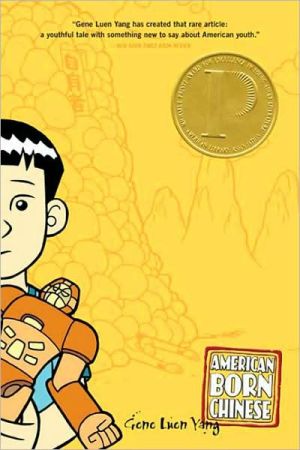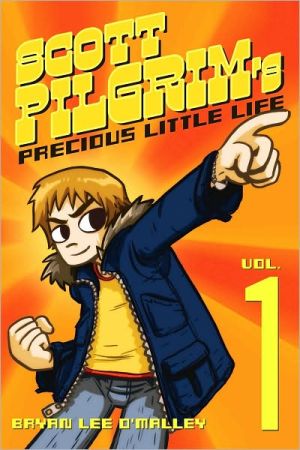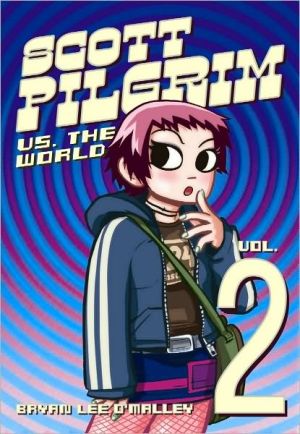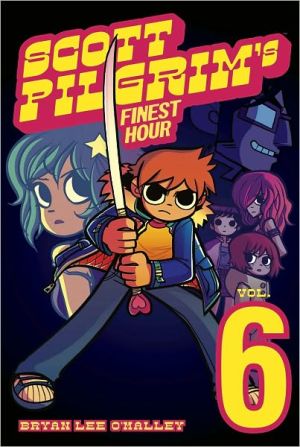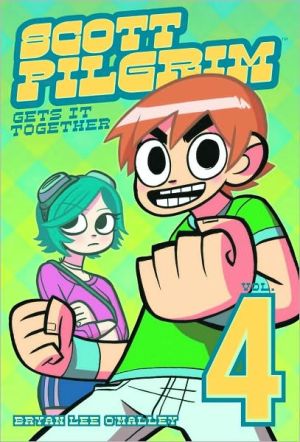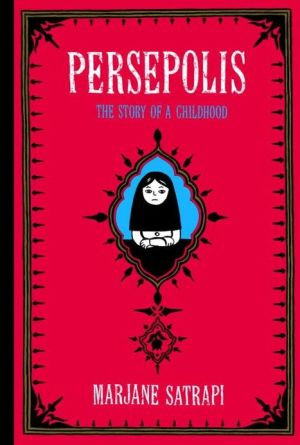American Born Chinese
Jin Wang starts at a new school where he’s the only Chinese-American student. When a boy from Taiwan joins his class, Jin doesn’t want to be associated with an FOB like him. Jin just wants to be an all-American boy, because he’s in love with an all-American girl. Danny is an all-American boy: great at basketball, popular with the girls. But his obnoxious Chinese cousin Chin-Kee’s annual visit is such a disaster that it ruins Danny’s reputation at school, leaving him with no choice but to...
Search in google:
Three very different characters, one simple goal: to fit in.Publishers WeeklyAs alienated kids go, Jin Wang is fairly run-of-the-mill: he eats lunch by himself in a corner of the schoolyard, gets picked on by bullies and jocks and develops a sweat-inducing crush on a pretty classmate. And, oh, yes, his parents are from Taiwan. This much-anticipated, affecting story about growing up different is more than just the story of a Chinese-American childhood; it's a fable for every kid born into a body and a life they wished they could escape. The fable is filtered through some very specific cultural icons: the much-beloved Monkey King, a figure familiar to Chinese kids the world over, and a buck-toothed amalgamation of racist stereotypes named Chin-Kee. Jin's hopes and humiliations might be mirrored in Chin-Kee's destructive glee or the Monkey King's struggle to come to terms with himself, but each character's expressions and actions are always perfectly familiar. True to its origin as a Web comic, this story's clear, concise lines and expert coloring are deceptively simple yet expressive. Even when Yang slips in an occasional Chinese ideogram or myth, the sentiments he's depicting need no translation. Yang accomplishes the remarkable feat of practicing what he preaches with this book: accept who you are and you'll already have reached out to others. (Sept.) Copyright 2006 Reed Business Information.
\ From the Publisher“Gene Luen Yang has created that rare article: a youthful tale with something new to say about American youth.”—New York Times Book Review\ “Like Toni Morrison’s The Bluest Eye and Laurence Yep’s Dragonwings, this novel explores the impact of the American dream on those outside the dominant culture in a finely wrought story that is an effective combination of humor and drama.”—School Library Journal, Starred Review\ “. . . brilliantly written and designed, sophisticated and wise.”—The Miami Herald\ “. . . one of the most powerful and entertaining works of literature to be published this year . . .”—The San Francisco Chronicle “Yang accomplishes the remarkable feat of practicing what he preaches with this book: accept who you are and you'll already have reached out to others.”—Publishers Weekly\ “Kids fighting an uphill battle to convince parents and teachers of the literary merit of graphic novels will do well to share this title.”—The Bulletin of the Center for Children’s Books\ “Each of the characters is flawed but familiar, and, in a clever postmodern twist, all share a deep, unforeseen connection. Yang helps the humor shine by using his art to exaggerate or oppose the words, creating a synthesis that marks an accomplished graphic storyteller. The stories have a simple, engaging sweep to them, but their weighty subjects––shame, racism, and friendship––receive thoughtful, powerful examination.”—Booklist “This graphic novel could be especially cathartic for teens and adults of Asian descent, but people of any ethnicity would find themselves reflected in the universal themes of self-acceptance, peer pressure, and racial tensions.”—Voice of Youth Advocates\ \ \ \ \ \ Publishers WeeklyAs alienated kids go, Jin Wang is fairly run-of-the-mill: he eats lunch by himself in a corner of the schoolyard, gets picked on by bullies and jocks and develops a sweat-inducing crush on a pretty classmate. And, oh, yes, his parents are from Taiwan. This much-anticipated, affecting story about growing up different is more than just the story of a Chinese-American childhood; it's a fable for every kid born into a body and a life they wished they could escape. The fable is filtered through some very specific cultural icons: the much-beloved Monkey King, a figure familiar to Chinese kids the world over, and a buck-toothed amalgamation of racist stereotypes named Chin-Kee. Jin's hopes and humiliations might be mirrored in Chin-Kee's destructive glee or the Monkey King's struggle to come to terms with himself, but each character's expressions and actions are always perfectly familiar. True to its origin as a Web comic, this story's clear, concise lines and expert coloring are deceptively simple yet expressive. Even when Yang slips in an occasional Chinese ideogram or myth, the sentiments he's depicting need no translation. Yang accomplishes the remarkable feat of practicing what he preaches with this book: accept who you are and you'll already have reached out to others. (Sept.) Copyright 2006 Reed Business Information.\ \ \ KLIATTAmerican Born Chinese is a graphic novel that tells the story of two protagonists. The Monkey King is a figure from Chinese folklore. Angry at not being admitted to a Heavenly Dinner Party because he isn't wearing shoes, the Monkey King masters the twelve disciplines of Kung Fu and sets about proving that he is a god to his fellow deities. He does this by beating up anyone who calls him a monkey. Danny, an Asian boy drawn with white features, wants to be like the rest of the kids in his high school. Unfortunately, the arrival of his cousin from China, Chin-Kee, dashes his hopes. Chin-Kee is every cliche about Chinese people (pronounce his name phonetically) rolled into one fun-filled package. Chin-Kee is so full of fun that a laugh track follows him around, but Danny, who has transferred out of two high schools already because of Chin-Kee's past antics, isn't laughing. There is also a third storyline featuring Jin Wang (Danny in junior high) and his best friend, Wei-Chen Sun. This is one of the best graphic novels I've read this year. It reminds me of Derek Kirk Kim's excellent Same Difference & Other Stories, which is also worth purchasing. The three storylines are interrelated, and all have the same theme: accept who you are. Be warned that the character of Chin-Kee will arouse strong feelings: some may find him offensive while others may think he's funny. American Born Chinese contains racial stereotypes, comic book violence, and one urinating monkey (from the back). It is highly recommended for all graphic novel collections.\ \ \ \ \ VOYAThree seemingly unrelated stories blend into a memorable tale of growing up Chinese American. The book begins with the ancient fable of the Monkey King, the proud leader of the monkeys. He is punished for entering the god's dinner party by being buried under a mountain for five hundred years. Second is the story of Jin Wang, the son of immigrants struggling to retain his Chinese identity while longing to be more Americanized. The final story is that of Cousin Chin-Kee, an amalgamation of the worst Chinese stereotypes. Chin-Kee yearly visits his all-American cousin Danny, causing so much embarrassment that Danny must change schools. The final chapter unifies the three tales into one version of what it means to be American-born Chinese. This graphic novel first appeared as a long running Web comic on the Moderntales website, where it enjoyed an enthusiastic following. The artwork is clean and distinctive, with varying panel styles and inking that is visually appealing. The Cousin Chin-Kee story line is extremely hyperbolic and at times difficult to read, as it embraces the most extreme negative Chinese stereotypes, but it displays some of the difficulties in perception faced by young Chinese Americans. This graphic novel could be especially cathartic for teens and adults of Asian descent, but people of any ethnicity would find themselves reflected in the universal themes of self-acceptance, peer pressure, and racial tensions. This book is recommended for libraries serving teens and adults, particularly those enjoying graphic novels.\ \ \ \ \ Library JournalA National Book Award finalist and ALA's Printz Award winner, this fable stars the mythological Monkey King, realistic youngster Jin Wang of Taiwanese parentage, and TV sitcom teen Danny. All three are dogged by an unwanted identity and humiliated by others' prejudice. The Monkey King trains to be a god but is unceremoniously bounced out of heaven and urged by "he who is" (the great god) to be what he is: a monkey. Jin tries to be accepted and romance a fellow student but gets picked on by classmates. Danny does well with friends until Chinese cousin Chin-Kee, a bitingly funny bundle of racist stereotypes, makes his annual visit and behaves so offensively that Danny must change schools. Finally, the three stories suddenly merge, to center on Jin coming to terms with his minority experience and moving beyond his own fear and hostility. Coalescence comes almost too quickly, but the trivision approach and treatment are unique and moving. The art is simple, colorful, and both attractive and effective. Some potty humor; recommended for teen and adult collections.\ —Martha Cornog\ \ \ \ \ \ School Library JournalGr 7 Up-Graphic novels that focus on nonwhite characters are exceedingly rare in American comics. Enter American Born Chinese, a well-crafted work that aptly explores issues of self-image, cultural identity, transformation, and self-acceptance. In a series of three linked tales, the central characters are introduced: Jin Wang, a teen who meets with ridicule and social isolation when his family moves from San Francisco s Chinatown to an exclusively white suburb; Danny, a popular blond, blue-eyed high school jock whose social status is jeopardized when his goofy, embarrassing Chinese cousin, Chin-Kee, enrolls at his high school; and the Monkey King who, unsatisfied with his current sovereign, desperately longs to be elevated to the status of a god. Their stories converge into a satisfying coming-of-age novel that aptly blends traditional Chinese fables and legends with bathroom humor, action figures, and playground politics. Yang s crisp line drawings, linear panel arrangement, and muted colors provide a strong visual complement to the textual narrative. Like Toni Morrison s The Bluest Eye and Laurence Yep s Dragonwings, this novel explores the impact of the American dream on those outside the dominant culture in a finely wrought story that is an effective combination of humor and drama.-Philip Charles Crawford, Essex High School, Essex Junction, VT Copyright 2006 Reed Business Information.\ \
